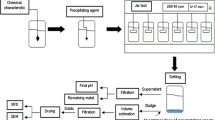The paper investigates the efficiency of a sludge prepared from a water treatment site of a combined heat and power plant (CHPP) when used as a sorbent for wastewater purification from copper and iron ions. In model solutions, the efficiency of purification from copper ions was determined to range from 80 to 100% at the initial copper concentration in the solution exceeding 0.5 mg/L. The purification efficiency in model solutions comprised 70–100% at the same initial concentration. The presence of both components in a model solution was determined to maintain the purification efficiency at iron and copper concentrations exceeding 0.5 mg/L. In addition, an increase in the purification efficiency was observed at iron and copper concentrations below 0.5 mg/L. An additional treatment of the sorbent by heat exposure to 200°C for 1 hour provides an increase in the purification efficiency at lower concentrations. At concentrations above 0.25 mg/L, the efficiency of purification from copper and iron ions comprises 80–100 and 60–100%, respectively, depending on the initial concentration. The efficiency of industrial wastewater purification from iron and copper ions using the proposed sorbent ranges from 30 to 70%, depending on the initial ion concentration.



Similar content being viewed by others
References
O.A. Fedyaeva, Industrial Ecology [In Russian], Izd. OmGTU, Omsk (2007).
O.D. Lukashevich and N.T. Usova, Vestnik Tomskogo Gos. Arkhitekturno-Stroit. Un-ta [In Russian], 20, No. 1, 148-159 (2018).
A.S. Kutergin and T.A. Nedobukh, Ekologiya i Prom-st’ Rossii [In Russian], 24, No. 3, 19-23 (2020). DOI: https://doi.org/10.18412/1816-0395-2020-3-19-23
L.A. Nikolaeva and E.N. Borodai, Resource-Saving Technology of Water Treatment Sludge Utilization at TPP [In Russian], KGEU, Kazan (2012).
A. Ghorpade and M. Ahammed, Environmental Eng. Res., 23, No. 1. 92-98 (2018). DOI: https://doi.org/10.4491/eer.2017.065
K.R. Tarantseva and O.V. Firsova, Chem. a. Petroleum Eng., 51, No. 5. 426-432 (2015). DOI: https://doi.org/10.1007/s10556-015-0063-7
G.I. Fishman and A.A. Litvak, Water Supply and Wastewater Treatment at Chemical Fiber Enterprises [In Russian], Khimiya, Moscow (1971).
Author information
Authors and Affiliations
Corresponding author
Additional information
Translated from Khimicheskie Volokna, No. 6, pp. 39-41, 2021.
Rights and permissions
Springer Nature or its licensor holds exclusive rights to this article under a publishing agreement with the author(s) or other rightsholder(s); author self-archiving of the accepted manuscript version of this article is solely governed by the terms of such publishing agreement and applicable law.
About this article
Cite this article
Tarantseva, K., Fayustova, Y. & Tirantsev, K. Efficiency of Water Treatment Sludge in Processes of Wastewater Purification from Copper and Iron Ions. Fibre Chem 53, 406–408 (2022). https://doi.org/10.1007/s10692-022-10314-5
Published:
Issue Date:
DOI: https://doi.org/10.1007/s10692-022-10314-5




